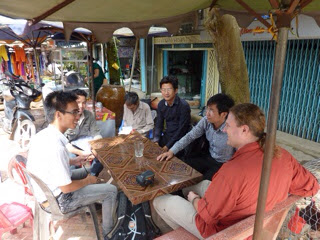And it is. Even fresh-water areas here have a strong tidal variation. Usually the people take advantage of the steady rising and falling of the water level, irrigating their rice fields and catching small shrimp to grow further in ponds and baskets. Water is central to life in the Mekong delta: until the government improved road infrastructure, most transport took place by boat. The floating markets around Can Tho are popular tourist destinations. But the water is a treacherous friend. In 2000 the Mekong raised about 5 meters high, submerging hundreds of thousands of houses, and drowning hundreds of people as well as cattle and crop. The area saw another big flood in 2011.
Expectations are that the flooding problem will get worse as the global climate gets warmer, bringing heavier rains and a higher sea level. But even a climate change skeptic should be able to see the importance of learning to deal with these heavy floods. Much of what the inhabitants can do makes sense even if no climate change occurs: strengthening dykes, building higher or stronger houses, buying insurance to cover the financial risks of crop and cattle loss. One of the big questions is what the government can or should do (planned adaptation in jargon), and what the local residents do (autonomous adaptation).
 |
| Binh is the smartly dressed gentleman in the center. The ponytailed Dutch guy in the ugly red shirt, that would be me. |
It was good to visit Binh's research site, and to see how he conducts his survey. I had not realised how complicated such surveys can be around here: just going from door to door, as you would do in countries like Kenya and Tanzania, is unlikely to work for several social and cultural reasons. Binh invited, through local authorities, respondents to come to the local community office where one of Binh's research assistants would interview them. It seems I have a lot to learn still about doing research in southeast Asia.


Geen opmerkingen:
Een reactie posten